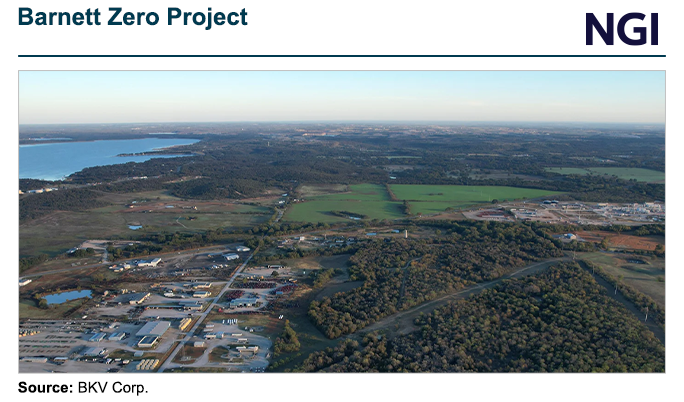The Barnett Shale’s top natural gas producer, BKV Corp., has secured a contract to develop and sell carbon sequestered gas, aka CSG, to a Texas facility at a “premium over Henry Hub prices.”

According to Denver-based BKV, CSG offers “Scope 1, 2 and 3 carbon-neutral” greenhouse gas (GHG) emissions, “effectively mitigating the environmental impact of natural gas consumption.”
Operators use the Greenhouse Gas Protocol by the World Resources Institute, which provides criteria to monitor direct-to-indirect emissions, otherwise known as Scope 1 (direct), 2 (indirect emissions that a company controls), and 3 (indirect emissions by customers).
“The introduction of CSG, and this sale to a world-class natural gas end user, aligns with our mission to help create a better world through our emission reduction and energy impact goals,” BKV CEO Chris Kalnin said.
Under the agreement, CSG would be delivered to the Fort Worth Maintenance Facility of Kiewit Corp. subsidiary Kiewit Infrastructure South Co. The gas would be supplied “directly from a pipeline” to the Markum Business Park.
Kiewit, a global construction and engineering operator, is one of the largest transportation contractors in North America. It constructs and upgrades interstates, highways, bridges and rail lines. It also constructs urban mass transit systems, along with airport runways and taxiways.
“We believe that our production of CSG can scale to meet future energy needs of many industries across the country and that this product will be synergistic with other approaches to sustainable energy helping to advance the reduction in greenhouse gas emissions,” Kalnin said.
BKV said CSG is generated ”by pairing low methane intensity natural gas and offsetting emissions associated with the entire gas value chain, which includes production, gathering, boosting, processing, transmission, distribution and use through permanent carbon sequestration.”
The Barnett Shale ushered in the golden age of natural gas in the United States in the early 2000s. Industry icon George P. Mitchell, through Mitchell Energy & Development Corp., proved that using hydraulic fracturing and horizontal drilling could successfully tap into gas resources (and later oil) from shale, limestone and other rock formations. At that time, it was considered “unconventional” production. Today, most rigs drill horizontal wells.
BKV became the Barnett’s largest gas producer in 2019 after buying assets from Devon Energy Corp. That transaction represented one of several by BKV in the Lower 48 since 2016. In 2022, BKV padded its portfolio with assets purchased from ExxonMobil subsidiaries XTO Energy Inc. and Barnett Gathering LLC.
Efforts to certify BKV’s natural gas production also intensified in 2022. At that time, development of a carbon capture utilization and sequestration (CCUS) project was begun adjacent to the Barnett assets, in partnership with EnLink Midstream LLC. EnLink agreed to transport gas to its processing plant in Bridgeport, TX. The carbon dioxide (CO2) waste stream is then captured and transported to a BKV facility, where it is compressed and then sequestered at an underground injection control well.
BKV’s project, dubbed Barnett Zero, was designed to achieve an average sequestration rate of up to 210,000 metric tons/year of CO2 equivalent emissions.
‘Level Of Transparency’
CSG “represents an opportunity for end users to purchase verified differentiated natural gas that is emissions-certified and registered using blockchain technology,” Kalnin said. “We believe this level of transparency and trust is critical for the energy transition…”
The point, he said, is to lead the way in the “production of carbon-neutral natural gas.”
Last September, BKV secured a contract to sell differentiated natural gas to Engie SA’s Engie Energy Marketing NA Inc., the North American subsidiary. Along with selling Engie Energy gas, BKV agreed to provide associated carbon-sequestered credits, or CSCs. These are “measured, third-party verified, carbon-sequestered products,” according to BKV.
Under the agreement, Engie would receive up to 10,000 MMBtu/d, with an “equivalent amount of gas tokens.” The tokens represent the environmental attributes associated with the production – and the CO2 captured from the gas stream.
Engie Energy Marketing President Ken Robinson said BKV was offering “innovative, differentiated gas products that are key to ensuring the role that natural gas can play as part of the energy transition.”
In addition to its natural gas production and sales, BKV is building a portfolio of gas-fired power generation capacity. Last year, it added to power generation holdings in Texas with a purchase in Bell County of the 758 MW Temple II combined-cycle gas plant. It previously had purchased the Temple I project.
The purchase was completed in partnership with Banpu U.S. Power Corp., which, like BKV, is a subsidiary of Thai-based Banpu Public Co. Ltd.
BKV’s CCUS efforts have expanded into Louisiana as well. Last year the company partnered with NuQuest Energy LLC to complete a carbon sequestration agreement with the State of Louisiana. The goal is to develop facilities and permanently sequester CO2 from local emissions sources.
Louisiana granted CCUS rights on 21,000 acres in St. Charles and Jefferson parishes to BKV subsidiary High West Sequestration LLC. High West plans to dispose of and permanently sequester CO2 waste from local emissions sources through permanent sequestration using injection wells on the designated acreage.







